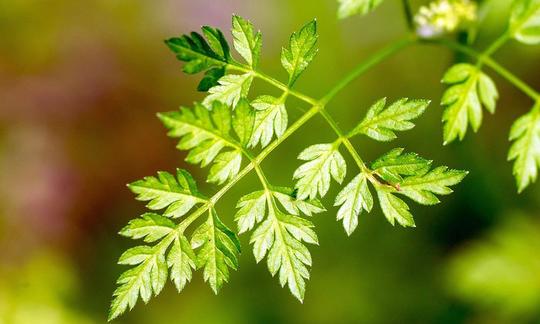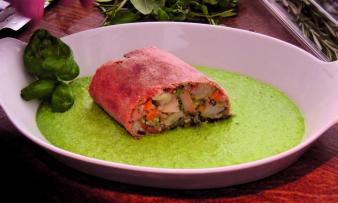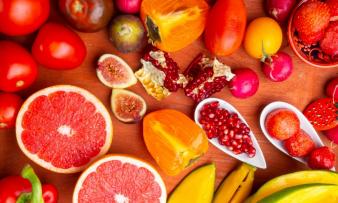Table of contents
What is chervil? Chervil ( Anthriscus cerefolium), known as garden chervil, is a wild or organically cultivated plant that can be eaten raw. In Switzerland, Chörblichrut is another name for chervil.
Use in the kitchen
Can you eat chervil raw? All parts of the plant are edible raw or cooked, such as tubers, first leaf shoots, leaves, budding inflorescences, fully blossomed flower plates, ripe fruits and roots.
The shoots (until April) can be cut into pieces and used as raw antipasti. Leaf shoots (March-April) and young chervil leaves taste good raw or in vegetable dishes. Finely chopped, they can be used as a seasoning. The aromatic and soft budding inflorescences (May) taste good in patties, vegetable fillings, soups or seasoning pastes. The fully blossomed flower plates (June-August) make a raw, edible decoration on salads and raw vegetables. They can be candied or dipped in batter and gently fried. The cut individual flowers flavor foods, drinks, wild plant salts, herbal oils and bread dough. Ripe fruits (July-September) are used as a seasoning for sauerkraut and bread dough or as sprouting seeds for fresh vitamins in winter. The roots (September to winter) can be grated raw into a salad or gently cooked as a vegetable.
Chervil spice should be added shortly before serving, as the fine, sweet and spicy aroma is lost through long cooking. The basic taste is reminiscent of a mixture of anise, caraway and fennel. The roots taste bitter and spicy. Chervil is used as a fresh, dried or frozen spice in many recipes - whether vegan or vegetarian.
One of the popular chervil recipes (in CH: Chörblichrut recipes) is, for example, (vegan) Frankfurter Grüne Sosse. Chervil is popular in French cuisine and is an integral part of the Fines herbes. It goes well with potato dishes and soups, which is why it is sometimes called soup herb or soup herbs. The plant species shares this alternative name with lovage, among others. Chervil is used as a spice in Norwegian cuisine, and is one of the most important herbs.
Suitable wild herbs for spring salads include chervil leaves, young yarrow leaves, watercress, daisies, nettle leaves, birch leaves and ground ivy.
Vegan recipe for potato soup with fresh chervil
Ingredients (for 2 people): 250 g floury potatoes, peeled and diced; a small onion, peeled and diced; 1 carrot, diced; 50 g yellow or red lentils ; 450 ml vegetable stock ; 50 g chopped chervil leaves with fine stems; approx. 10 g chervil flowers from 2 umbels.
Preparation: Bring the chopped vegetables to the boil with the lentils and vegetable stock. After cooking for about 20 minutes, puree the soup with a hand blender until it reaches the desired consistency. Finally, stir in chopped leaves of the soup herb. Pour the soup into bowls and decorate with flowers.
Vegan recipes with chervil can be found under the note: " Recipes that have the most of this ingredient ".
| Not only vegans or vegetarians should read this: Vegans often eat unhealthily. Avoidable nutritional errors. |
Purchasing - Storage
Where can you buy chervil (fresh)? Customers only occasionally find the herb in retail stores. You can buy it in supermarkets such as Migros, Coop, Spar or Interspar, Edeka (Kräutertopf) or Rewe. We have not yet found any real chervil at Denner, Volg, Aldi, Lidl, Hofer or Billa or the organic supermarket chains Denn's Biomarkt or Alnatura. The spice is available in specialist shops cut, dried and shredded. It is available in conventional and organic quality.
Can you buy fresh chervil? The herb is available in raw food quality in stores, for example Migros and Coop sometimes offer fresh chervil. The raw herb is also available in organic shops, health food stores, directly from the farmer, in a green box (seasonal box, subscription box) or at the weekly market.
The availability of chervil varies depending on the size of the store, catchment area, etc. If you are interested, click on our recorded food prices for the DA-CH countries (above under the ingredient image). There you will find current prices from various supermarkets and their price development.
Storage tips
Can you freeze chervil? Freezing is better than drying when storing fresh herbs. 1 The aroma and essential oils are better preserved this way. You can put a bunch of raw herbs in a freezer bag and freeze them. If necessary, you can chop up the solidified herbs in the bag from the outside with your hands and use them fresh.
Found in the wild
What does chervil look like? The so-called garden chervil has hollow, furrowed stems. The leaves, which smell of anise, are delicate, finely feathered and bright green. In summer, tiny white flowers appear in umbels, from which elongated seeds develop in autumn. The plant species reaches a height of between 30 and 60 cm and a width of 23-30 cm. 1
Be careful, real chervil can be confused with poisonous lookalikes. You can find more information below under "Risk of confusion - possibilities of confusion".
There are wild populations of Anthriscus cerefolium that originate from garden plantations. These cultivated forms differ from native wild forms, 3 which bear hairy fruits. 4 Released or wild populations can be found in ruderal bushes, alluvial forests, forest clearings, hedges and herbaceous areas. 4,5
Ingredients - Nutritional values - Calories
Here we realistically show you the ingredients of spices and herbs per 1 g (instead of per 100 g as usual).
According to the Austrian nutritional table ( ÖNWT), 1 g of raw chervil contains a calorie content of 0.58 kcal. Carbohydrates are represented at 0.06 g/1g, fats at 0.01 g/1g and proteins at 0.04 g/1g. The fresh herb is particularly rich in vitamin A (retinol equivalent) at 9 µg/1g. 6
More vitamin A in raw wild herbs can be found in sorrel (12.5 µg/1g) and less in lovage (6.67 µg/1g), dandelion (5.08 µg/1g) or narrow-leaved willowherb (2.86 µg/1g). 7.8
Other ingredients include bitter substances, furocoumarins, essential oil 14 and the two flavonoids flavones (apigenin and luteolin) and flavonols (kaempferol, quercetin, and isorhamnetin). 9 In a study, the chemical profile of the methanolic extract was examined for phenolic acids and flavonoids and 32 compounds were identified. 10
The leaves contain about 0.4% essential oil. 9 Scientists in the Vienna area examined the composition of the essential oil from above-ground parts of the plant. Estragole and 1-allyl-2,4-dimethoxybenzene dominate and occur in varying proportions. The essential oil from the fruits contained 95% estragole. The proportion of estragole was also higher in the young flowering plants. 11
The complete ingredients of chervil, the coverage of the daily requirement and comparison values with other ingredients can be found in our nutrient tables. In the article Nutrients explained you will get a detailed insight into the topic.
Effects on health
Does chervil have any health effects? From a scientific point of view, the plant has hardly been studied. 10 The Pubmed database contains fewer than ten studies on the health effects of Anthriscus cerefolium. These do not include clinical studies, meta-analyses or (systematic) reviews, but mainly in vitro studies. These are general basic studies - not carried out on humans, but on cell lines in a test tube. Antioxidative, antimicrobial and anticarcinogenic properties seem to have been best studied.
Is chervil healthy? Methanol extracts of Anthriscus cerefolium have a high antioxidant capacity, comparable to that of parsley. This property is due to the phenol content. Both species have the same main flavones, apiin and apigenin, but the most important phenolic component of Anthriscus cerefolium is a novel bicyclic lactone, which the current study reports in May 2022. The substance showed moderate activity against human leukemia and normal cell lines. 9
In another study, the effect of chervil (extract) on glioblastoma, the most malignant of all brain tumors, was investigated in vitro. The cell lines showed reduced growth (proliferation) and a change in cell morphology. 10
In the same study, the antimicrobial activity of the extract was tested against Staphylococcus aureus and Candida species, inhibiting free-floating cells and microbial biofilms. 10 Scientists attribute the observed antimicrobial activity of chervil extracts to the content of relatively volatile compounds, including the known antibiotic compound carvacrol. 9
In another study, the antioxidant activity of standardized aqueous chervil extracts was investigated using various in vitro test methods. The researchers were able to confirm the antioxidant and antilipoperoxidative effects. In all experiments, the herbal extract showed better activity than the root extract. 12,13
Risk of confusion
Is there a risk of confusion with parsley (flat)? In the early stages of growth , Anthriscus cerefolium and parsley ( Petroselinum crispum) look very similar. This is why chervil is sometimes called French parsley. A smell test can provide information. To do this, rub the leaves with your fingers. Chervil has a sweet smell that is reminiscent of anise and fennel, while parsley has a spicy, peppery smell. Both types are edible.
Anthriscus cerefolium is similar to the related bulbous goiter ( Chaerophyllum bulbosum), sometimes called chervil turnip or turnip-calf goiter. Its starchy and alkaloid-free tubers are reminiscent of small, short carrots and have a taste similar to sweet chestnuts. After the tuber has been frozen, the gourmet vegetable is reminiscent of hazelnuts. The leaves and fruits contain very volatile toxic ingredients that can cause dizziness, headaches and diarrhea. Poisoning has so far only been observed in livestock. 5
You can find more edible and poisonous lookalikes HERE under the same subtitle of the ingredient cow parsley. Find out more about the chervil plant through pictures and descriptions from reliable guides.
Folk medicine - natural medicine
The use of chervil in alternative medicine has a long tradition. What do you do with chervil? The plant is used as a diuretic and diaphoretic herb and because of its digestive and blood-purifying properties. The bitter substances it contains are said to stimulate the secretion of gastric and bile juices. 14
Garden chervil is popularly used for spring cures. Fresh plant pulp is traditionally applied externally to treat skin inflammations and eczema. 14 To avoid a secondary infection, raw plant components should only be applied when the skin is not injured.
Ecological footprint - animal welfare
The ecological CO2 footprint of garden chervil depends on many factors, such as the country of cultivation, processing, packaging and transport. Despite extensive research, however, we were unable to find any precise figures on the emissions generated. We also found no precise information on water consumption.
In conventional agriculture, synthetic pesticides and herbicides are often used to combat pests. However, these also have a negative impact on the surrounding ecosystem 18 and affect birds, fish, insects (such as important pollinators) and humans. 19 When buying chervil, you should therefore look for organically grown chervil, as this does not use such pesticides.
Chervil's flowering period is from April to August/September. The flowers, which are "nectar-bearing disc flowers" in terms of flower ecology, offer a rich early summer to early autumn nectar. The flower visitors include insects of all kinds, especially hoverflies and beetles. Nectar is the general term for the food that the bees bring in, i.e. nectar, pollen and honeydew. The nectar value of the meadow chervil is high and the pollen value medium (nectar value and pollen value scale: none, low, medium, high, very high). 14.20
Worldwide occurrence - cultivation
Chervil originates from Western Asia 3 and is considered an indigenous species in Germany (Central Europe), which means it was present there before 1492. 15 Cultivated and wild forms exist. 4
Cultivation - Harvest
How should you cultivate chervil? Garden chervil is suitable for container cultivation and grows in shady, cool locations. It can be planted together with other shade-loving herbs such as lemon balm or apple mint 1 ( green mint).
The soil should retain moisture, be rich in nutrients and be light. In cool regions, Anthriscus cerefolium can be grown as a pot plant or under plastic sheets, so that you can harvest it into the winter. High temperatures, lots of sun and dryness encourage the chervil plants to shoot. The herb keeps snails away and protectslettuce from aphids and ants. If you plant radishes in the immediate vicinity, they are said to develop a spicier taste. 1
From spring to the beginning of autumn, the seeds can be sown at intervals of 2 to 4 weeks. Before the chervil flowers, the leaves are harvested by cutting off the stems (similar to parsley). 1 The outdoor season is from March to August. The herb is grown in greenhouses all year round. In Germany, there were two producers in 2004 who grew the herb organically on 0.2 hectares. 16
Is chervil perennial or annual? Most plants are annual. There are biennial varieties that are hardy.
Further information
Chervil – what is it? Chervil ( Anthriscus cerefolium) belongs to the genus Chervil and comes from the family Apiaceae. The variety Anthriscus cerefolium var. cerefolium is well known, a cultivated form that is used as a spice.
Depending on the author, a distinction is made between the cultivated form Anthriscus cerefolium (L.) HOFFM. var. cerefolium and the wild form Anthriscus cerefolium var. trichocarpus NEILR. (Syn.: Anthriscus cerefolium subsp. trichospermus (NEILR.) ARCANG.). In the cultivated form, the fruit is smooth, shiny and bare except for very fine papillae, while the fruits of the wild form are covered with stiff, short and upwardly curved bristles.
Alternative names
True chervil - another name? The most common alternative name is garden chervil. Other common names are chervil, Chörblichrut, Karweil, Karwel, Kerbelkraut, Kerbeln, Kervelda, Kerveln, Kerwel, Kirbele, Kirfel, Körbelkraut, Körblinkraut, Körffel, Keferfil, Suppenkrätel, 2 Kerbelkraut, Kärbel, French parsley or Franzosenparersilie.
Old High German names are Charvel, Chervilla, Cherville, Chervola, Fünfblettir, Gerwella, Kervela, Kervila and Kervola. In Middle High German, names such as Carvel, Kärben, Karbel, Kertzenplatt, Kervel, Kerble, Kerbol, Kirbel, Korbel or Kurbel are known. In Middle Low German, it was called Carvel. 2
Chervil in English is called chervil (in German: Kerbel. Kerbel in Spanish is called Perifollo and in French Cerfeuil.
Latin names are Cerefolium sativum Besser, Chaerefolium cerefolium (L.) Thell., Chaerophyllum cerefolium Crantz, Chaerophyllum sativum Lam., Scandix cerefolium L., Anthriscus cerefolium subsp. cerefolium, Chaerefolium cerefolium var. sativum (Lam.) Thell., Anthriscus cerefolium subsp. trichosperma Nyman, non [var.] Endl. 1830, nom. illeg., Chaerefolium cerefolium var. trichospermum Thell., Chaerophyllum trichospermum Schult., non Lam. 1782, nom. illeg., Anthriscus cerefolium var. longirostris (Bertol.) Cannon, Anthriscus cerefolium var. trichosperma Endl., non (L.) Wimm & Grab. - Fl. Siles. 1(1):291 (1827), nom. illegal, Anthriscus trichosperma Spreng., non Pers. 1805, nom. illegal and Anthriscus longirostris Bertol. 5
Bibliography - 16 Sources (Link to the evidence)
| 1. | Bown D. Kräuter. Die grosse Enzyklopädie. Anbau und Verwendung. München: Dorling Kindersley; 2. Auflage. 2015. |
| 2. | Archive.org Anthriscus cerefolium (L.) Hoffm. |
| 3. | Infoflora.ch Anthriscus cerefolium (L.) Hoffm. Garten-Kerbel. |
| 4. | Vetmeduni.ac.at Echter Kerbel, Garten-Kerbel. Anthriscus cerefolium. |
| 5. | Ufz.de BiolFlor. Anthriscus cerefolium (L.) Hoffm. |
| 6. | Nutritional-software.at Kerbel frisch. BLS3.02 G069100. |
| 9. | Slimestad R, Rathe BA, Aesoy R, Diaz AEC, Herfindal L, Fossen T. A novel bicyclic lactone and other polyphenols from the commercially important vegetable Anthriscus cerefolium. Sci Rep. 2022;12(1):7805. |
| 10. | Stojković D, Drakulić D, Schwirtlich M, et al. Extract of herba anthrisci cerefolii: chemical profiling and insights into its anti-glioblastoma and antimicrobial mechanism of actions. Pharmaceuticals (Basel). 2021;14(1):55. |
| 11. | Chizzola R. Composition of the essential oils from Anthriscus cerefolium var. trichocarpa and A. caucalis growing wild in the urban area of Vienna (Austria). Nat Prod Commun. 2011;6(8):1147-1150. |
| 12. | Fejes S, Blázovics A, Lugasi A, Lemberkovics E, Petri G, Kéry A. In vitro antioxidant activity of Anthriscus cerefolium L. (Hoffm.) extracts. J Ethnopharmacol. 2000;69(3):259-265. |
| 13. | Fejes S, Blázovics A, Lemberkovics E, Petri G, Sz’’oke E, Kéry A. Free radical scavenging and membrane protective effects of methanol extracts from Anthriscus cerefolium L. (Hoffm.) and Petroselinum crispum (Mill.) nym. ex A.W. Hill. Phytother Res. 2000;14(5):362-365. |
| 14. | Fleischhauer SG, Guthmann J, Spiegelberger R. Enzyklopädie. Essbare Wildpflanzen. 2000 Pflanzen Mitteleuropas. Aarau: AT Verlag; 1. Auflage. 2013. |
| 15. | Floraweb.de Anthriscus cerefolium (L.) Hoffm. |
| 16. | Bundesanstalt für Landwirtschaft und Ernährung (BLE). Heil- und Gewürzpflanzen im ökologischen Landbau. 2004. 02OE156. |
| 18. | Sharma A, Kumar V, Shazad B, et al. Worldwide pesticide usage and its impacts on ecosystem. SN Applied Sciences. 2019. |
| 19. | Hernandez AF, Parron T, Tsatsakis AM, et al. Toxic effects of pesticide mixtures at a molecular level: Their relevance to human health. Toxicology. 2013; 136-145. |
- Katharina Hofer, MSc Organic Agriculture
- Luise Völlm, BA in Ecotrophology, Certified Business Administrator (IHK), Herbalist
- Johanna Sommerauer BSc, BSc Environmental and Bioresource Management, Stud. Master Organic Agric.
- Heidemarie Alberta Pirker, Dr. nat. tech., Organic Farming & Nature Conservation









Comments